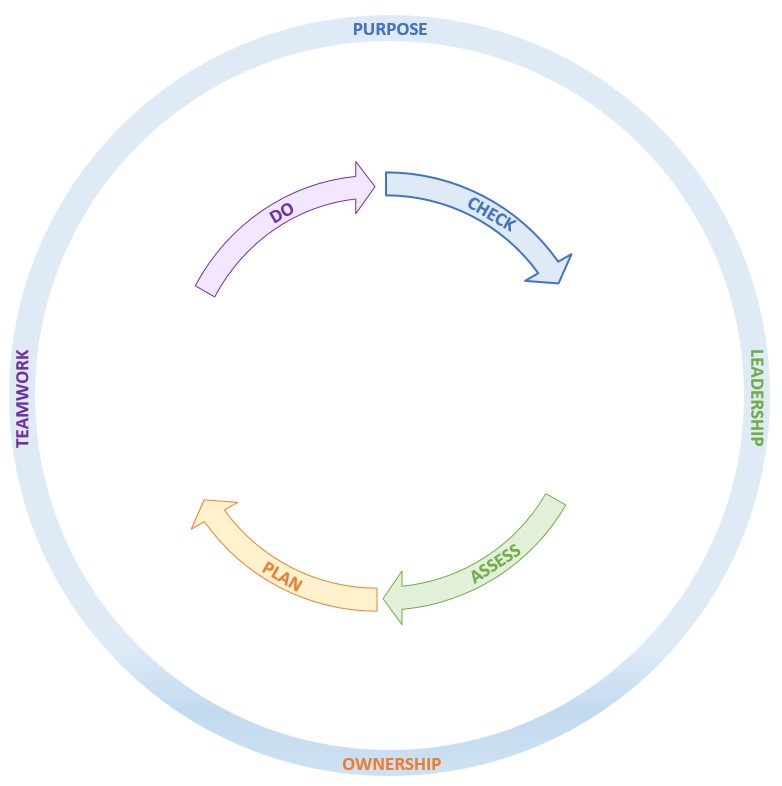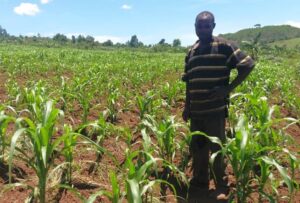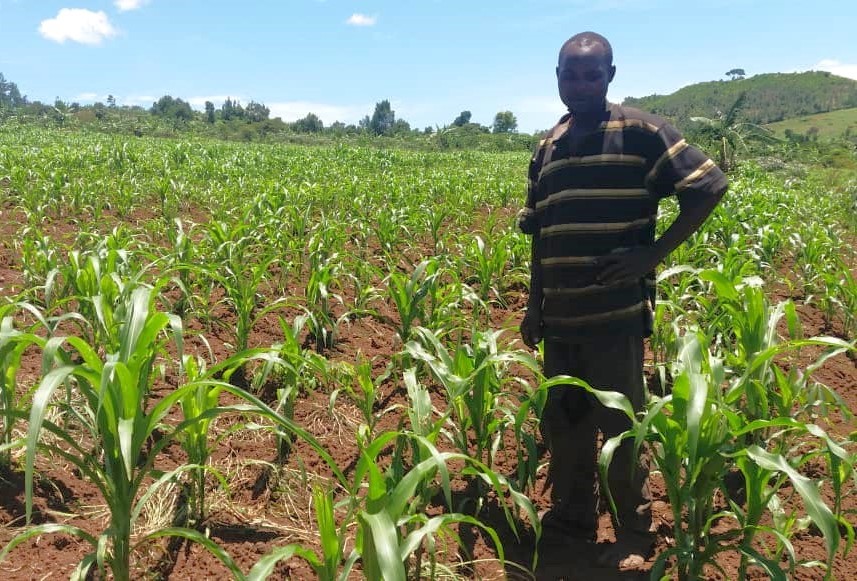Kasaka, UG – Wamukisa uses continuous improvement cycle for second season of staple crop joint venture – Oct 2023
Kato is standing in maize grown for one month on one acre of land rented for growing staple crops for a program that shares expenses paid, and then divides sale profits earned by the partners in the same proportion as they paid expenses. Following the success of Zinabala VICOBA’s staple crop growing business that employs member families and earns profit for members to share. Wamukisa and leader Michael formed a Joint Venture (JV) using the continuous improvement cycle ( PLAN, DO, CHECK, ASSESS) to grow staple crops for sale and to develop a new form of partnership.

For 2023 Rain Season 1, the PLAN was for the JV to DO soil preparation in February, and to DO planting mid and late March of inter-cropped beans and maize using the organic soil nourishment method developed by Zinabala ( https://betterlives.org/2022/02/kikondo-ug-zinabala-community-banking-group-has-used-its-training-to-nourish-soil-for-march-planting-28-feb-2022/ ). With good growing weather, we estimated to harvest 300 kg of beans and 2,500 kilograms of maize. But the unknown previous farming methods on the land left the soil with unknown fertility. Late season rains decreased the bean harvest. CHECK of the harvest yielded only 157 kg of beans and 1,000 kg of hulled maize. Fortunately for income, the market price of maize improved over estimated, from 700 shillings per kilogram to 1,000 shillings right after harvest, and to 1,190 shillings per kilogram a few weeks later. The JV earned a small profit. It was time to ASSESS the gap between expected harvest and actual.
Experienced farmers in Kasaka suggested using more expensive Tembo maize seeds for higher yields in the area. They suggested mono-cropping maize seeds planted closer together instead of inter-cropping with beans. Published studies suggested adding larger amounts of nitrogen at the time of planting, and more at mid-season. Also, storing dried crops right after harvest time, for later sale instead of when market supply is high, seems to gain a higher price but risks loss to rodents and insects.
Which growing conditions affected crop harvests in one season is always difficult to ASSESS. Every farmer must always adapt to unpredictable rain amount and timing. Soil amendment needs for an upcoming season vary depending on inputs and outputs over many seasons. At the time of planting, future market prices are unknown and only larger farms in Uganda can arrange future crop sale at a guaranteed price. Despite uncertainty, people who depend on their farm harvests for food must plant to live.
The Season 2 JV Plan emphasizes achieving profit by changing several inputs. At Season 2 planting in September, we planted improved Tembo maize seeds spaced closer for more maize plants with no beans. With the seeds we added to the soil 10 sacks of manure instead of the 5 used Season 1. Kato stands in the healthy plants, waiting to add more manure when they are waist high. With good rains, harvest and profits should improve when we CHECK again, but by changing many inputs in one season we have made it difficult to ASSESS which input changes were most effective to earn profit. In a future with more land cultivated over more seasons, we can PLAN to DO CHECKs and ASSESS change to one input at a time in many areas.
The Season 2 Plan estimates all improvements combined will increase the harvest to at least 2 tonnes of maize. We will store it in rodent and insect resistant bags until prices rise some weeks after harvest season. We are challenged by market price changes that affect our income from sales. Maize prices can vary 70% or more at different times in differing seasons. We are engaging with produce traders so that we can follow and learn price changes. We believe prices won’t be too low for us to make profit.


